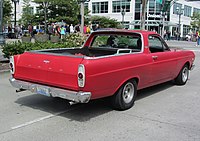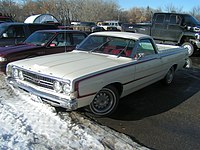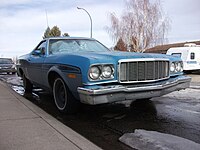Ford Ranchero
| Ford Ranchero | |
|---|---|
The Ford Ranchero is a
During the 1970s, the Ranchero name was used in the
The original Ranchero sold well enough to spawn a competitor from General Motors in 1959, the Chevrolet El Camino.[6]
History
The first
First generation (1957–1959)
| First generation | |
|---|---|
Ford-O-Matic automatic | |
| Dimensions | |
| Wheelbase | 116–118 in (2,946–2,997 mm)[9] |
| Length | 202.0 in (5,131 mm)[10] |
| Width | 78.2 in (1,986.3 mm) |
| Height | 59.9 in (1,521.5 mm) |
Introduced in December 1956, three months after the traditional September model year start-up, the Ranchero was based on the standard and new-for-1957 full-sized
Upscale models were badged both as a Fairlane and Ranchero, with a stylized representation of a
The 1958 version remained largely unchanged under the skin save for the new front sheet metal (shared by the big '58 Ford and inspired by the Thunderbird)[10] and its new four-headlamp arrangement. The 1957 rear end and tail lights were reused on the 1958 Ranchero.
The 1959 model was built with the same 118 in (3,000 mm) wheelbase as all 1959 Fords, giving the Ranchero the advantage over its predecessors of a new, longer 7 ft (210 cm) bed.[11] However, this would be the last time the vehicle would grow either in size or trim for several years to come. The windshield was also 25% larger.[11] Seatcovers were vinyl or "woven plastic",[11] while the spare tire was located behind the passenger seat.[11] The Custom Ranchero was the only model marketed in 1959,[10][12] and was offered in 26 colors (11 solid shades, 11 two-tone combinations with white on top, and four other two-tone choices).[11]
-
1957 Ford Custom Ranchero
-
1958 Ford Ranchero
-
1958 Ford Ranchero, rear
-
1959 Ford Ranchero
Second generation (1960–1965) Falcon Ranchero
| Second generation | ||
|---|---|---|
Curb weight | 2,475 lb (1,123 kg) | |
In 1960, the Ranchero became much smaller, based on Ford's compact
Three almost entirely different coupé utility bodies were available for this generation of Falcon: the Australian Falcon Ute differed in having a shorter rear overhang than North American models, a cargo box that extended farther forward than the rear window, and shorter doors, while the Argentinian version also shared the sedan's overall length and short "four-door" doors, adding higher and more squared-off cargo box sides.
The Ranchero evolved along with the Falcon in 1964, becoming just a little larger along with its parent and using the same basic body style for 1964 and 1965. In 1965, the 289 cu in (4.7 L) V8 replaced the discontinued 260 and an
-
1960 Ford Falcon Ranchero
-
1962 Ford Falcon Ranchero
-
1963 Ford Falcon Ranchero rear
-
1963 Ford Falcon Ranchero
-
1964 Ford Falcon Ranchero
-
1965 Ford Falcon Ranchero
Third generation (1966–1967)
| Third generation | |
|---|---|
⧉) | |
| Body and chassis | |
| Related | Ford Falcon Ford Fairlane |
| Powertrain | |
| Engine | 170 cu in (2.8 L) I6 200 cu in (3.3 L) I6 289 cu in (4.7 L) V8 390 cu in (6.4 L) V8 |
| Transmission | 3-speed automatic 3-speed manual 4-speed manual |
| Dimensions | |
| Wheelbase | 113.0 in (2,870 mm)[10] |
The 1966 version was a one-year model, when Falcon and Fairlane were redeveloped on the same basic platform, one which did not include the sedan delivery, as 1965 marked the final year of sedan delivery production. Instead, the 1966 Ranchero used Falcon front sheet metal, trim, and interior accents on a modified station wagon platform although Rancheros made late in the '66 model year had the same front clip as the Fairlane.[15] Engines available were the 170 cu in (2.8 L) I6, 200 cu in (3.3 L) I6, and two- and four-barrel versions of the 289 cu in (4.7 L) V8. Transmissions choices ranged from the C4 three-speed automatic to the three-speed column-shifted manual. The 1966 model was marketed simply as the Ford Ranchero,[16] and did not carry Falcon badges.[17] Seat belts were standard.[10]
The 1967 Ranchero, based on the post-'66 Falcon/Fairlane chassis, used the basic 1966 Ranchero body with Fairlane trim, front sheet metal, and interior treatments instead of Falcon. It was marketed as the Fairlane Ranchero.[18]
This was a well-received and unique one-year vehicle, with clean, straight lines, dual stacked headlamps, and plenty of power; the Ranchero had entered the muscle car arena in 1967. Engine options started with a 200 cu in (3.3 L) straight-6 and went up to a 390 cu in (6.4 L) FE-series V8 giving 315 bhp (234.9 kW) and backed by an optional C6 automatic, the new-for-1966 heavy duty variant of the C4 in addition to the tried and true Toploader 4-speed manual gearbox. The '67 also had the largest expansion of trim levels since the vehicle's introduction 10 years prior. Supplementing the base model were the new Ranchero 500 and 500/XL. In spite of being added to the Fairlane family for 1967, Ford's top performance options for the Fairlane - the GT and the GTA - did not apply to the Ranchero and is a common misconception that they were available.
What did apply to all American cars in 1967 was the use of a dual-circuit braking system with a dual-chambered master cylinder. Increased awareness of passenger safety resulted in such innovations as safety-padded windshield pillars and an unusual 1967-only safety pad which protruded from the center of the three-spoked steering wheel to a point just beyond the rim of the steering wheel. It was designed to minimize abdominal injuries in the event of a collision.
-
Schematic of Ford's 170 and 200 cid engines used in their automobiles from the early 1960s to 1980s
-
1966 Ford Ranchero
-
1966 Ford Ranchero, rear
-
1967 Ford Fairlane 500 Ranchero
-
Interior image of a 1967 Ford Ranchero with bench seat and three-speed shifter on the steering column
Fourth generation (1968–1969)
| Fourth generation | |
|---|---|
| Powertrain | |
| Engine | 250 cu in (4.1 L) I6 289 cu in (4.7 L) V8 390 cu in (6.4 L) V8 428 cu in (7.0 L) V8 302 cu in (4.9 L) V8 351 cu in (5.8 L) V8 |
| Transmission | 3-speed manual 4-speed manual 3 speed automatic |
| Dimensions | |
| Wheelbase | 113.0 in (2,870 mm) |
In 1968, the Fairlane line was supplemented by the new
Three trim levels were offered, beginning with the sparsely trimmed base Ranchero, the Ranchero 500 trimmed like the corresponding Fairlane 500, and the top-of-the line Ranchero GT with its Torino GT trim. Engine choices began with the 250 cubic inch I6 and ran to several V8 choices, including the standard 289 with two-barrel carburetor, and the FE-based 390. The powerful 428 cu in (7.0 L)
Like the Torino/Fairlane, the Ranchero could be had with virtually all of the same options as its cousins, including air conditioning, bucket seats, center console, AM/FM radio, optional wheels, front power disc brakes, hood scoop (standard on GT), and even a vinyl top. Changes across the 1969 model line were slight and included a flatter three-piece grille less the horizontal crossbar and Ford crest, relocation of GT grille badging from the crest to the lower right corner of the grille as viewed from the front, a change from black-faced instruments with white numerals to brushed aluminum with black numerals and a slimmer, two-spoke steering wheel pad similar to those across the Ford product line, unlike the wheel with its broader "safety pad" and separate horn ring used in the 1968 intermediates and compacts. While the pad may have changed, the horn ring did not. The only change unique to the Ranchero was the relocation of the "Ranchero" script from the rear quarter panels to the front fenders.
A little-known and extremely rare offering in 1969 was the Rio Grande. Available on special order, this was essentially a GT in the so-called "Grabber" colors of "Wimbledon White", "Poppy Red" or "Calypso Coral", partially blacked-out hood with scoop, side stripes, bed rails, vinyl top, and unique "Ford Ranchero Rio Grande" wheel centers. As a result, Rancheros so equipped received Ford's "Special Performance Vehicle" identification on the data plate regardless of engine choice. These vehicles may be identified by the aforementioned designation, as well as a blank space where the trim code would normally be found. Production figures are unclear, but may have been around 900 total units.
At the Detroit motor show in 1969 was shown a concept car Ford Scrambler, some elements of which were used in the next models of Ford Ranchero.
-
1968 Ford Ranchero GT
-
1969 Ford Ranchero GT (with after-market-wheels)
-
A351 Windsor V8 engine from a 1969 Ford Mustang. The Ranchero's installation was similar.
-
1969 Ford Scrambler (Ranchero Concept)
Fifth generation (1970–1971)
| Fifth generation | |
|---|---|
 1970 Ford Ranchero Squire | |
| Overview | |
| Production | 1970–1971 |
| Assembly | Lorain, Ohio, United States (⧉) |
| Body and chassis | |
| Related | Ford Torino Mercury Montego |
| Powertrain | |
| Engine | 250 cu in (4.1 L) I6 302 cu in (4.9 L) V8 351 cu in (5.8 L) V8 429 cu in (7.0 L) V8 |
| Dimensions | |
| Wheelbase | 114.0 in (2,896 mm) |
While Chevrolet's El Camino used the same body from 1968 to 1972, 1970 had a complete restyle for the Ranchero, which had started with a boxy body style. Both the Torino and Ranchero featured a shallow-pointed grille and front end with smooth, somewhat more curvaceous lines influenced by coke bottle styling. A fourth trim option was made available in 1970. The Ranchero Squire was an upmarket trim package which featured a woodgrain applique similar to that found on the Country Squire station wagon. Like in previous years, all Torino trim and engine options could be ordered, including all-new Ram-Air 429 Cobra Jet or Super Cobra Jet engines (7 L) with the new "shaker" hood scoop, so named because it was directly mounted to the carburetor and shook with the engine at idle. Also available was a stylish grille that featured hide-away headlamps, as well as an optional hood with an oversized scoop which was standard on Torino GTs. The 1971 is distinguished by a grille divided by a center section.
A minor but nevertheless important variation debuted with the 1970 model. Prior to 1970, no Ranchero had any interior badging identifying it as such. With the 1970 model came a "Ranchero" or "Ranchero GT" badge on the glove compartment rather than Fairlane or Torino badging.
-
1970 Ford Ranchero Squire
-
1971 Ford Ranchero Squire
-
1971 Ford Ranchero GT rear
-
1971 Ford Ranchero GT interior
Sixth generation (1972–1976)
| Sixth generation | |
|---|---|
Atlanta, Georgia, United States (⧉) | |
| Body and chassis | |
| Related | Ford Elite Ford Torino Mercury Montego Mercury Cougar |
| Powertrain | |
| Engine | 250 cu in (4.1 L) I6 302 cu in (4.9 L) V8 351 cu in (5.8 L) V8 400 cu in (6.6 L) V8 429 cu in (7.0 L) V8 460 cu in (7.5 L) V8 |
| Transmission | 4-speed manual 3-speed automatic |
| Dimensions | |
| Wheelbase | 118.0 in (2,997 mm)[19] |
| Length | 215.7 in (5,479 mm) |
| Width | 79.0 in (2,007 mm) |
| Height | 53.5 in (1,359 mm)[20] |
In 1972, a radical change occurred in the Torino and Ranchero lines. The sleek, pointy look of the previous year's model was replaced with a larger, heavier design. Most prominent was a wide semioval grille reminiscent of a jet intake and a new body-on-frame design. Three models were still available; the now-standard 500, the new Squire with
The 1973 Ranchero had a redesigned front end to meet new federal standards for front impact protection. Aside from slight cosmetic differences, the Ranchero remained basically the same until the Torino's final year, 1976.
-
1972 Ford Ranchero 500
-
1973 Ford Ranchero (with after-market wheels)
-
1974–1976 Ford Ranchero
-
1974–1976 Ford Ranchero
Seventh generation (1977–1979)
| Seventh generation | |
|---|---|
 | |
| Overview | |
| Production | 1977–1979 |
| Assembly | Lorain, Ohio, United States (⧉) |
| Body and chassis | |
| Related | Ford LTD II Ford Thunderbird Mercury Cougar |
| Powertrain | |
| Engine | 302 cu in (4.9 L) V8 351 cu in (5.8 L) V8 400 cu in (6.6 L) V8 |
| Dimensions | |
| Length | 220.1 in (5,591 mm)[10] |

With the Torino ending production after 1976, the 1977 Ranchero was restyled in line with the Ford LTD II mid-sized car line which replaced the Torino using the same platform. The same three models available since 1968 were still offered and the Ranchero could be ordered in quite luxurious form. Engines fitted went up to the 400 cu in (6.6 L). Production ceased in 1979 with, among the traditional choices, a commemorative "1979½" model. Although the LTD II-based Ranchero was not produced for many model years, this body style with stacked rectangular headlamps is one of the most popular among collectors. This generation of Ranchero is often customized by swapping onto it any front end clip from a 1972–1976 Mercury Montego, 1974–1979 Mercury Cougar, 1974–1976 Ford Elite, or 1977–1979 Ford Thunderbird, which all have interchangeable front end parts that easily bolt into place.
Cars were getting smaller and increasing government restrictions, and requirements on a car-based pickup truck made such a vehicle less and less attractive from a manufacturing standpoint. Meanwhile, purpose-designed light trucks had to meet much less stringent requirements for emissions and fuel economy. Ford saw the way the market was going and decided small light trucks were the wave of the future, beginning with the Mazda-built Courier pickup. This vehicle would be a "stepping stone" during which time Ford would develop their homegrown replacement, the Ranger.
Argentine Ranchero

From 1973 until 1991,
Later that year, it became the best-selling car in Argentina, with a total of 110,382 sold between 1973 and 1978.[5] Production of the second-generation model lasted from 1978 until 1982, and production of the third generation lasted from 1982 until 1987. In 1987, the fourth and final generation was released and in 1988 a diesel model was added to the lineup for the first time, but it was discontinued as of 1989. Production of the fourth-generation Argentine Ranchero ended in 1991.[21]
Present day

Rancheros are reasonably collectible, though they are nowadays often overlooked in favor of the later-arriving
The idea of a car-based pickup remains an attractive one and is an illustration of how favorable treatment for light trucks over cars by United States regulations skews the marketplace. Many Ranchero and El Camino owners, indeed, stopped buying new vehicles when those models were discontinued.
In Australia, Ford produced a right-hand drive car-based "pickup", with the FG X Falcon Ute available in style-side or tray-back form. Production of Falcon sedans and utilities ceased in Australia in 2016.
References
- ^ 1958 Meteor Ranchero, www.flickr.com Retrieved 4 December 2019
- ^ "Ford Ranchero History and Production Figures". Dearborn Classics. Retrieved 2009-10-30.
- ^ 1972 Ranchero Bakkie - Australian XA Falcon Ute Retrieved on 8 May 2010
- ^ How the humble Falcon ute became a Ford RancheroRetrieved 1 April 2023
- ^ a b "FORD FALCON 1973" (in Spanish). Todo Falcon. Retrieved 16 October 2011.
- ^ "Chevrolet El Camino". OldRide.com. Retrieved 16 October 2011.
- ^ "The First Ute Broadcast 06/02/2003". Abc.net.au. Retrieved 2011-11-20.
- ^ oldcarsweekly.com
- ^ a b "Directory Index: Ford_Ranchero/1957_Ford_Ranchero_Foldout". Oldcarbrochures.com. Retrieved 2011-11-20.
- ^ ISBN 0-87341-238-9.
- ^ a b c d e Old Car Brochures Archived 2013-10-12 at the Wayback Machine Retrieved 5 October 2013.
- ^ Mike Mueller, Pickup Trucks, 1999, p.127 As retrieved from books.google.com.au on 19 February 2011
- ^ "Directory Index: Ford_Ranchero/1965_Ford_Ranchero_Foldout". Oldcarbrochures.com. Retrieved 2011-11-20.
- ^ "Directory Index: Ford_Ranchero/1961_Ford_Ranchero_Foldout". Oldcarbrochures.com. Retrieved 2011-11-20.
- ^ 1966 Ford Ranchero with Fairlane front clip Retrieved from momentcar.com 7/23/2017
- ^ 1966 Ford Ranchero brochure Retrieved from www.webcitation.org on 19 February 2011
- ^ 1966 FORD FALCON PRODUCTION FIGURES Archived 2010-12-02 at the Wayback Machine Retrieved from www.westcoastfalcons.com on 19 February 2011
- ^ 1967 Ford Fairlane Ranchero advertisement Retrieved from www.flickr.com on 19 February 2011
- ^ "Directory Index: Ford_Ranchero/1975_Ford_Ranchero_Brochure". Oldcarbrochures.com. Retrieved 2011-11-20.
- ^ American Light Trucks and Utility Vehicles, 1967-1989 Every Model, Year by Year By J. Kelly Flory Jr. pg410 | 20May2020
- ^ "FORD MOTOR ARGENTINA S.A." (in Spanish). Coche Argentino. Retrieved 16 October 2011.
- ^ Motor City Resin Casters. "72' Ranchero Trans-Kit".
- ^ MotorTrend.com First Look: 2012 Ford Ranger - 90 Percent of an F-150, 100 Percent Not Coming Here - Benson Kong, 15 October 2010
- ^ "2019 Ford Ranger First Look: Welcome Home". Motor Trend. January 14, 2018. Retrieved 2018-01-20.



























